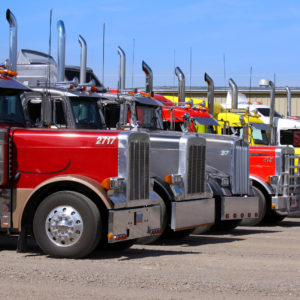Amid the panic buying and hoarding of toilet paper in March came calls to shore up America’s supply chain — and a plea to allow for bigger trucks on the interstates.
On March 19, a coalition called Americans for Modern Transportation sent a letter to Congress asking for truck size limits on all interstates to be raised from a maximum of 28-foot twin trailers to 33-foot twin trailers.
“As you explore innovative solutions to meet the immediate needs of our nation, we hope you will consider the benefits of allowing for a modest, five-foot length increase to the existing national standard for twin trailers,” the letter reads, saying the change will “encourage immediate manufacturing investments and bring meaningful benefits that will help our country return to pre-coronavirus levels of production and consumption.”
Members of the coalition include UPS, FedEx, Amazon, Sysco, PODS, the U.S. Chamber of Commerce, the National Association of Manufacturers, the National Retail Federation and the American Bakers Association, among others.
The change would bring the total maximum length of trucks on interstates to 91 feet — about six times the length of a Honda Civic, and then some.
Twenty states now allow twin 33-foot trailers on state roadways and the lobbyist heading up Americans for Modern Transportation, Randy Mullett, says UPS and FedEx have been running twin 33’s regularly — UPS, from Salt Lake to Denver, and FedEx on the Florida Turnpike, from Orlando to Fort Lauderdale and back.
“There have been no DOT-reportable crashes yet involving these units over the last seven years… We know that big does not translate into dangerous,” Mullett said in an interview this week.
But a lot of people don’t want bigger trucks. They include railroads, the National League of Cities, the National Sheriff’s Association and the U.S. Conference of Mayors.
The Coalition Against Bigger Trucks — made up of emergency medical technicians and law enforcement organizations — warns that bigger and heavier trucks cause more damage to roads and bridges and put highway troopers at greater risk.
On twin 33s, the coalition points to a 2015 Department of Transportation (DOT) study that showed trucks with twin 33 trailers take 22 feet longer to stop than trucks with twin 28s. Longer stopping distances mean more crashes. In general.
But good data has been hard to come by.
The most recent DOT study, done in 2016, found there was not enough data on crashes and damage to roads and bridges from increased truck sizes to make any determinations.
“At the conclusion of the Technical Reports, the Department believed that the current model and data limitations were so profound that the results could not accurately be extrapolated to confidently predict national impacts,” the agency wrote, saying no changes in truck size and weight laws should be made until more is known.
And opponents of bigger trucks have thus far carried the day.
In 2015, a bipartisan amendment sponsored by Sens. Diane Feinstein (D-Calif.) and Roger Wicker (R-Miss.) sunk a move to allow bigger trucks on interstates.
But industry is pushing for the change, and asking members of Congress to include language allowing bigger trucks in the next coronavirus stimulus bill.
Bigger trucks, they say, means fewer total trucks on the interstates — 18 percent fewer trucks as the twin 33-foot trailers can hold 18 percent more than twin 28-foot trailers.
Congress already gave the OK to states to raise maximum truck weight limits from 80,000 pounds to 100,000 pounds for a period of 120 days to aid in moving critical supplies across the country during the pandemic and the recovery.
But a coalition of law enforcement officers sent a letter to governors asking them to make sure the change is temporary.
“Limits on the size and weight of trucks are essential to ensure that our highways are safe and to preserve our infrastructure,” they wrote.

